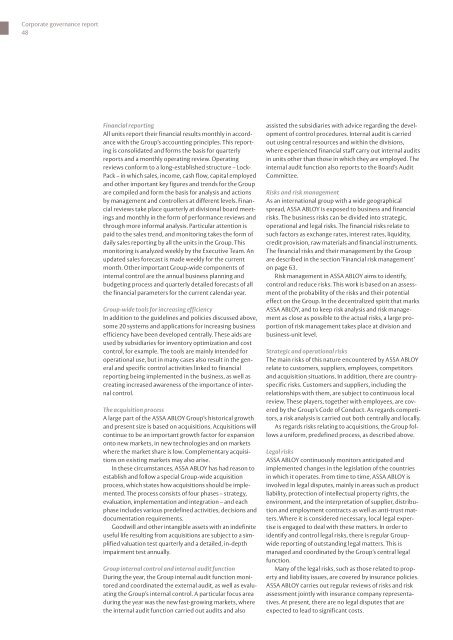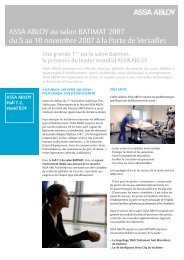You also want an ePaper? Increase the reach of your titles
YUMPU automatically turns print PDFs into web optimized ePapers that Google loves.
Corporate governance report<br />
48<br />
Financial reporting<br />
All units report their financial results monthly in accordance<br />
with the Group’s accounting principles. This reporting<br />
is consolidated and forms the basis for quarterly<br />
reports and a monthly operating review. Operating<br />
reviews conform to a long-established structure – Lock-<br />
Pack – in which sales, income, cash flow, capital employed<br />
and other important key figures and trends for the Group<br />
are compiled and form the basis for analysis and actions<br />
by management and controllers at different levels. Financial<br />
reviews take place quarterly at divisional board meetings<br />
and monthly in the form of performance reviews and<br />
through more informal analysis. Particular attention is<br />
paid to the sales trend, and monitoring takes the form of<br />
daily sales reporting by all the units in the Group. This<br />
monitoring is analyzed weekly by the Executive Team. An<br />
updated sales forecast is made weekly for the current<br />
month. Other important Group-wide components of<br />
internal control are the annual business planning and<br />
budgeting process and quarterly detailed forecasts of all<br />
the financial parameters for the current calendar year.<br />
Group-wide tools for increasing efficiency<br />
In addition to the guidelines and policies discussed above,<br />
some 20 systems and applications for increasing business<br />
efficiency have been developed centrally. These aids are<br />
used by subsidiaries for inventory optimization and cost<br />
control, for example. The tools are mainly intended for<br />
operational use, but in many cases also result in the general<br />
and specific control activities linked to financial<br />
reporting being implemented in the business, as well as<br />
creating increased awareness of the importance of internal<br />
control.<br />
The acquisition process<br />
A large part of the ASSA ABLOY Group’s historical growth<br />
and present size is based on acquisitions. Acquisitions will<br />
continue to be an important growth factor for expansion<br />
onto new markets, in new technologies and on markets<br />
where the market share is low. Complementary acquisitions<br />
on existing markets may also arise.<br />
In these circumstances, ASSA ABLOY has had reason to<br />
establish and follow a special Group-wide acquisition<br />
process, which states how acquisitions should be implemented.<br />
The process consists of four phases – strategy,<br />
evaluation, implementation and integration – and each<br />
phase includes various predefined activities, decisions and<br />
documentation requirements.<br />
Goodwill and other intangible assets with an indefinite<br />
useful life resulting from acquisitions are subject to a simplified<br />
valuation test quarterly and a detailed, in-depth<br />
impairment test annually.<br />
Group internal control and internal audit function<br />
During the year, the Group internal audit function monitored<br />
and coordinated the external audit, as well as evaluating<br />
the Group’s internal control. A particular focus area<br />
during the year was the new fast-growing markets, where<br />
the internal audit function carried out audits and also<br />
assisted the subsidiaries with advice regarding the development<br />
of control procedures. Internal audit is carried<br />
out using central resources and within the divisions,<br />
where experienced financial staff carry out internal audits<br />
in units other than those in which they are employed. The<br />
internal audit function also reports to the Board’s Audit<br />
Committee.<br />
Risks and risk management<br />
As an international group with a wide geographical<br />
spread, ASSA ABLOY is exposed to business and financial<br />
risks. The business risks can be divided into strategic,<br />
operational and legal risks. The financial risks relate to<br />
such factors as exchange rates, interest rates, liquidity,<br />
credit provision, raw materials and financial instruments.<br />
The financial risks and their management by the Group<br />
are described in the section ‘Financial risk management’<br />
on page 63.<br />
Risk management in ASSA ABLOY aims to identify,<br />
control and reduce risks. This work is based on an assessment<br />
of the probability of the risks and their potential<br />
effect on the Group. In the decentralized spirit that marks<br />
ASSA ABLOY, and to keep risk analysis and risk management<br />
as close as possible to the actual risks, a large proportion<br />
of risk management takes place at division and<br />
business-unit level.<br />
Strategic and operational risks<br />
The main risks of this nature encountered by ASSA ABLOY<br />
relate to customers, suppliers, employees, competitors<br />
and acquisition situations. In addition, there are countryspecific<br />
risks. Customers and suppliers, including the<br />
relationships with them, are subject to continuous local<br />
review. These players, together with employees, are covered<br />
by the Group’s Code of Conduct. As regards competitors,<br />
a risk analysis is carried out both centrally and locally.<br />
As regards risks relating to acquisitions, the Group follows<br />
a uniform, predefined process, as described above.<br />
Legal risks<br />
ASSA ABLOY continuously monitors anticipated and<br />
implemented changes in the legislation of the countries<br />
in which it operates. From time to time, ASSA ABLOY is<br />
involved in legal disputes, mainly in areas such as product<br />
liability, protection of intellectual property rights, the<br />
environment, and the interpretation of supplier, distribution<br />
and employment contracts as well as anti-trust matters.<br />
Where it is considered necessary, local legal expertise<br />
is engaged to deal with these matters. In order to<br />
identify and control legal risks, there is regular Groupwide<br />
reporting of outstanding legal matters. This is<br />
managed and coordinated by the Group’s central legal<br />
function.<br />
Many of the legal risks, such as those related to property<br />
and liability issues, are covered by insurance policies.<br />
ASSA ABLOY carries out regular reviews of risks and risk<br />
assessment jointly with insurance company representatives.<br />
At present, there are no legal disputes that are<br />
expected to lead to significant costs.
















